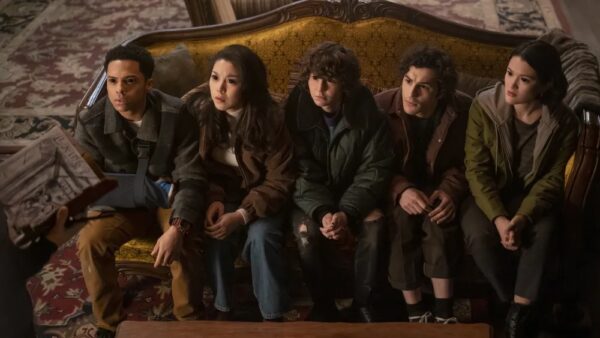Television: “Goosebumps” — Disney’s Subpar Version of “Stranger Things”
By Sarah Osman
Goosebumps is pretty much a failure as a series because it lacks most of R.L. Stine’s entertaining alchemy.

A scene from Goosebumps. Photo: David Astorga/Disney
If you grew up in the ’90s, you would know (or could safely assume) that the Goosebumps table was among the hottest at the Scholastic Book Fair. These bestselling twisted tales by R.L. Stine proffered the perfect meld of thrills, humor, and horror; they were page turners skillfully designed to terrify. Many kids read them in bed, the book in one hand and a flashlight in the other. Among the series’ scary highlights: haunted cameras, creepy worms, and Slappy, the most disturbing of all ventriloquist dolls. At the same time, Stine brilliantly wove in comedic elements that kept the series from veering into creepy-to-the-max Stephen King territory, though Stine served as an introduction to King for many kids. Goosebumps still remains popular, but for the adolescents of the ’90s these lightly macabre tales are particularly memorable.
Attempting to either capitalize on Gen Z’s love of Stranger Things or Millennials’ nostalgia for Goosebumps, Disney+ has rebooted the series. The attempt is pretty much a failure because there is little of Stine’s entertaining alchemy. For one, Disney’s attempt at an “edgy” series for tweens/teens lacks the tangy fun of both Stranger Things and the original Goosebumps. Its creators made an elemental mistake: they set the action in the present day. On top of that, the series does away with the camp factor that made Stine’s books as amusing as they were nerve-wracking.
There are some attempts at camp here. Justin Long, who stars as the new English teacher who may not be who he says he is, relishes any opportunity to chew the cinematic scenery. Arguably one of Hollywood’s most unappreciated actors, Long obviously adores over-the-top roles; he knows how absurd this series is and does his flamboyant best, from childishly sipping on chocolate milk to slipping and sliding down a hallway. The best moments in Goosebumps involve an enthusiastic Long, who I suspect may be a Stine fan himself.
The same can’t be said for the other actors, who, in all fairness, are stuck with middling scripts. The plot follows five high schoolers who know each other, but don’t start to collaborate/collide until a Halloween party is held at the aforementioned new English teacher’s house. There, several monstrosities are released and things go awry. The more interesting moments focus on how a cursed object might affect a high school student. One girl feels invisible and is pushed by a mask to be “more confident;” another boy wants to be liked by everyone and he ends up spawning multiple versions of himself. If the series simply focused on the kids dealing with these cryptical/magical objects it would be effective. Alas, the marketing-minded writers Googled “what Gen Z likes” and have shoehorned in what they think Gen Z would like to see. This is depressingly true for James, who is gay, and who we are (often) reminded is gay. He dresses up as a sexy kitty — because he’s gay! He doesn’t know about sports — because he is gay! Gen Zers like the gays, so here’s a gay! Why couldn’t James just be a human being who just happens to be gay?
And then there are the parents. Let’s face it: the most boring part of any high school series is the adults. And the species in Goosebumps are particularly tedious. Apparently, the objects these kids encounter are meant to torment their banal parents. The set-up is part of a bogus mythology. The new Goosebumps would have been much more powerful if it had been presented as an anthology series that focuses on the high school and featuring characters from previous episodes. Or as a season-long episode arc focused solely on the kids.
It’s not surprising then, that the best episode stands on its own. Taking a deep dive into the backstory of Slappy, that sinister dummy, the sixth episode doesn’t take place in the present day. It starts in the 1920s and ends in 1993: it provides answers to questions posed throughout the series, such as who the evil objects belonged to and what exactly the parents did. Given its impressive set design, stronger writing, and cohesive storyline, episode six proves that the anthology approach would have been the way to go. Too bad Disney+ didn’t turn to Slappy for advice.
Sarah Mina Osman is a writer residing in Wilmington, NC. In addition to writing for the Arts Fuse, she has written for Watercooler HQ, Huffington Post, HelloGiggles, Young Hollywood, and Matador Network, among other sites. Her work was included in the anthology Fury: Women’s Lived Experiences in the Trump Era. She is currently a first year fiction MFA candidate at the University of North Carolina Wilmington. When she’s not writing, she’s dancing, watching movies, traveling, or eating. She has a deep appreciation for sloths and tacos. You can keep up with her on Twitter and Instagram: @SarahMinaOsman
